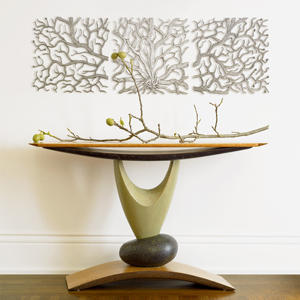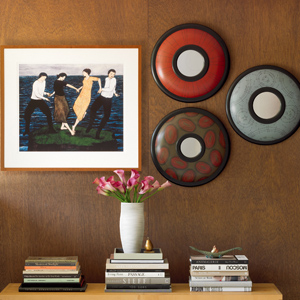For a more casual atmosphere, try hanging your art diagonally or in groupings. Photo courtesy of Artful Home
Art at Work
Did you know that the shape of your artwork helps define your space? If you want to elongate your room, select vertical or rectangular-shaped art. To make a room seem taller, or to emphasize high ceilings, try choosing taller frames.
-
Become a Picture-Hanging Pro
The "do"s and "don’t"s of hanging artwork.
- by Deborah R. Huso
Have you ever walked into someone’s home and found yourself startled because pictures on the wall were hung too high or because an otherwise beautiful portrait was swallowed by a large wall? You may not know how to fix the problem, but your eye knows something is wrong.
“Art needs to fill the space,” says Calif.-based metal artist B.J. Keith. “Remember that you’re creating a composition on your wall.” That means doing some planning, which isn’t as hard as it sounds. “Set your pieces of art on the floor, and rearrange them until you find something that pleases you,” she advises.
Below are some basic professional tips for ensuring your art is hung properly and enhances the space it occupies:
Placing Art
- Pay attention to scale. If you’re hanging art over a large sofa, for example, don’t use a small print. If you have high ceilings, consider using vertical artwork.
- Groupings of several small pieces of art often work well on a blank wall. Just be sure to place them the same distance apart.
- Dare to be different. If you're hanging a grouping of pictures, don’t use the same matting and framing for every picture, but do use complementary colors and frame styles.
How to Hang Art
- Don’t hang too much on one wall. If the composition looks too busy, it probably is.
- Use horizontal art where you want to elongate a room and vertical art where you want to make ceilings look taller.
- For a formal look, use an even number of frames and space them equal distance from each other. For a more casual atmosphere, choose an odd number of pieces and try hanging them diagonally or in groupings.
- Always use picture hooks rated for the weight of your artwork, and be sure to place hooks in wall studs when hanging heavier pieces.
Common Mistakes
- Hanging artwork too high. A general rule of thumb, unless you’re doing a grouping of pictures, is to hang art at eye level, about 60 inches from the floor.
- Elaborate frames and matting. Don’t overdo it with matting and framing. Simple frame styles and neutral matting often work best to draw your eye to the art. When in doubt, it’s hard to beat a classic white mat and black frame.
- Matting that gets lost. For picture matting that draws attention to your art, use a color that contrasts the color of the wall. Or, to make it really pop, double mat with the underneath mat mirroring the wall color.
- Failing to relate artwork to furniture. If you hang a picture over a table, for example, the bottom of the frame should only be 4 to 8 inches from the top of the table.



